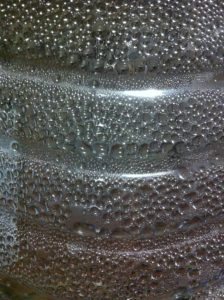Many people think that only wood fireplaces must be inspected every year. This is wrong! Gas fireplaces must also be inspected. They do not have creosote build-up but they can have a lot of other areas that need attention and periodic maintenance. A yearly gas fireplace inspection will catch problems with your gas fireplace and its venting system before these problems become serious issues that could have a negative effect on your health and home. Below are some of the reasons why many homeowners hire chimney companies like ours to inspect their gas fireplaces every year.
Incomplete Combustion & Condensation Problems

The Chimney Safety Institute of America (CSIA) explains that the efficiency of a modern gas fireplace can cause two different problems: incomplete combustion and condensation. This can happen because more heat is put into the room instead of going up the chimney to create the draft that makes the system function correctly. If your gas fireplace is vented to an older chimney designed for hotter exhaust, the cooler temperature affects its performance.
- Incomplete combustion occurs when not enough air is pulled into the appliance. A gas fireplace needs 10 cubic feet of air for every 1 cubic foot of natural gas to completely combust. Not enough air means the fireplace cannot function correctly. It also tends to allow dangerous carbon monoxide to seep into the room rather than venting to the outside.
- Condensation occurs when water forms on the inside of the venting system. This happens when the interior surface of the vent is cooler than the gasses passing through it. Just as water forms on a glass of iced tea when the air is hot, condensation forms inside your chimney when it is cooler than the air it vents. This moisture is not pure water, however. This is usually a corrosive mix of chemicals that can eat away at all it touches.
Inspections Catch What You Can’t See Yet

Condensation and incomplete combustion are not the only things that affect the performance of your gas fireplace. A certified inspector is trained and equipped to recognize the clues that show your gas fireplace and its venting system are in need of attention.
- Ceramic and artificial logs start to deteriorate and shed debris that clogs vents.
- Some chimney damage can only be seen from getting on the roof and looking at the structure. Crown damage, broken fireclay liners, and crumbling mortar do not repair themselves.
- Other chimney damage can only be seen by visual inspection of the inside. This can be accomplished with equipment that is lowered into the chimney if interior damage is suspected.
- The inner working parts of gas fireplaces wear over time. Such wear can compromise the safety of your gas fireplace. Fireplaces can develop gas leaks. Gas leaks can lead to toxic fumes entering the home.
- In some cases gas leaks can lead to serious fires and health concerns.
The Number One Reason…Peace of mind

The number one reason to get a yearly inspection for your gas fireplace and its venting system is your peace of mind. The ease of instantly having a cozy hearth full of flickering flames is the appeal of a gas fireplace. No soot, no fuel collecting, no ash cleanup — gas fireplaces can’t be beaten for convenience and comfort. But they need to be maintained if they are to be used safely. With an annual inspection, you know if your gas fireplace is ready for the heating season or if you need to attend to its maintenance. With that assurance, you can be confident that your gas fireplace is to be enjoyed just like it was when it was initially installed.
